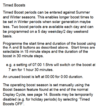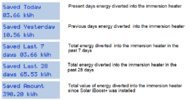- Joined
- 27 Jan 2008
- Messages
- 24,923
- Reaction score
- 2,882
- Location
- Llanfair Caereinion, Nr Welshpool
- Country

It takes 60 seconds to run off cold water before hot arrives, it also takes 60 seconds to boil a cup boiler, (50 seconds to boil 10 seconds to be ejected into the cup) so it seems hardly worth it to fit a local water heater to wash hands down stairs. Specially since I would loose cupboard space.
However this time of year we tend to run out of hot water, solar panels heat the water once battery is full, but this time of year, we get bad days, yesterday purple line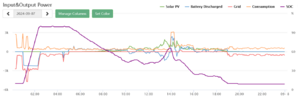 the battery never charged from solar, only the off peak charged battery, which lasted us until nearly 8 pm so not bad, but by today
the battery never charged from solar, only the off peak charged battery, which lasted us until nearly 8 pm so not bad, but by today 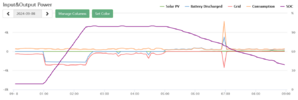 water is cold, and it seems likely again no solar to reheat it. Once the central heating is running, we can't stop the DHW being heated, and the central heating does the whole tank, where the immersion only does top foot, so heated with central heating hot water lasts 3 days, but not with the immersion heater.
water is cold, and it seems likely again no solar to reheat it. Once the central heating is running, we can't stop the DHW being heated, and the central heating does the whole tank, where the immersion only does top foot, so heated with central heating hot water lasts 3 days, but not with the immersion heater.
So the question is, what, if anything, to do about it? Options are:-
1) Under sink boiler.
2) Longer immersion heater.
3) Program a boost time into the iboost+
4) Swap the iboost+ immersion heater controller for a time clock and use off peak.
5) Just boil a cup of water when we have no solar. i.e. do nothing.
The problem with the boost time, is we don't realise we need it, until after the water has cooled, most days we get a pattern like this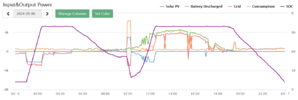 and the flat top to the state of charge curve means we had more solar than required, so immersion heater has heated the DHW, so just a few days in Autumn and Spring when we run out. Typically we use around 0.6 kWh per day to heat the DHW, so hardly worth spending out a lot of money to cover the days when we run out, but I can't be the only one with this problem. So any idea I have not thought about?
and the flat top to the state of charge curve means we had more solar than required, so immersion heater has heated the DHW, so just a few days in Autumn and Spring when we run out. Typically we use around 0.6 kWh per day to heat the DHW, so hardly worth spending out a lot of money to cover the days when we run out, but I can't be the only one with this problem. So any idea I have not thought about?
However this time of year we tend to run out of hot water, solar panels heat the water once battery is full, but this time of year, we get bad days, yesterday purple line
 the battery never charged from solar, only the off peak charged battery, which lasted us until nearly 8 pm so not bad, but by today
the battery never charged from solar, only the off peak charged battery, which lasted us until nearly 8 pm so not bad, but by today  water is cold, and it seems likely again no solar to reheat it. Once the central heating is running, we can't stop the DHW being heated, and the central heating does the whole tank, where the immersion only does top foot, so heated with central heating hot water lasts 3 days, but not with the immersion heater.
water is cold, and it seems likely again no solar to reheat it. Once the central heating is running, we can't stop the DHW being heated, and the central heating does the whole tank, where the immersion only does top foot, so heated with central heating hot water lasts 3 days, but not with the immersion heater.So the question is, what, if anything, to do about it? Options are:-
1) Under sink boiler.
2) Longer immersion heater.
3) Program a boost time into the iboost+
4) Swap the iboost+ immersion heater controller for a time clock and use off peak.
5) Just boil a cup of water when we have no solar. i.e. do nothing.
The problem with the boost time, is we don't realise we need it, until after the water has cooled, most days we get a pattern like this
 and the flat top to the state of charge curve means we had more solar than required, so immersion heater has heated the DHW, so just a few days in Autumn and Spring when we run out. Typically we use around 0.6 kWh per day to heat the DHW, so hardly worth spending out a lot of money to cover the days when we run out, but I can't be the only one with this problem. So any idea I have not thought about?
and the flat top to the state of charge curve means we had more solar than required, so immersion heater has heated the DHW, so just a few days in Autumn and Spring when we run out. Typically we use around 0.6 kWh per day to heat the DHW, so hardly worth spending out a lot of money to cover the days when we run out, but I can't be the only one with this problem. So any idea I have not thought about?


